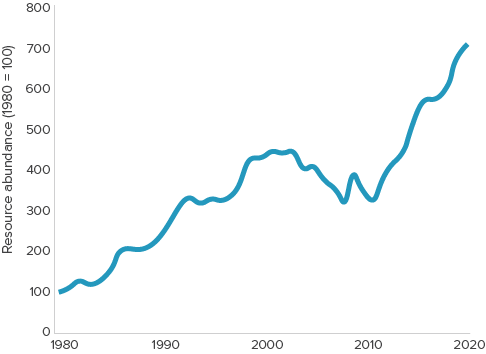On November 15, 2022, the 8 billionth child will be born on Planet Earth. Is it a cause for celebration or despair?
For long, we were told that the world had excess population and the rate at which it is growing, we might soon need two earths to feed them. Surprisingly, a new book with a contrarian view, backed with hard data, tries to prove that the birth of the 8 billionth child is good news for the earth. Here’s why?
In Superabundance: The Story of Population Growth, Innovation, and Human Flourishing on an Infinitely Bountiful Planet, (August 2022), Marian Tupy and Gale Pooley argue how resources have become abundant even as the population grew. They analyzed prices of hundreds of commodities, goods, and services spanning two centuries, They show how resource abundance increased faster than the population growth – a relationship that they call “superabundance.” On an average, every additional human being created more value than he or she consumed.
The authors used the concept of ‘time prices,’ which represent the length of time that people must work to buy something. To them this relationship between population growth and abundance is deeply counterintuitive. For example, the time-price for an Indian to buy enough rice for one day has fallen from 7 hours in 1960 to under one hour today. So, abundance — the technical term is ‘personal resource abundance multiplier’ — has risen seven-fold.
Their central premise is that more people produce more ideas, which lead to more inventions. “People then test those inventions in the marketplace to separate the useful from the useless. At the end of that process of discovery, people are left with innovations that overcome shortages, spur economic growth, and raise standards of living.” But large populations are not enough to sustain superabundance. People must be allowed to think, speak, publish, associate, and disagree. They must be allowed to save, invest, trade, and profit. In a word, they must be free.
Doomsayers vs. Optimists
Swaminathan S Anklesaria Aiyar, Consulting Editor at The Economic Times, is glad the book has taken on the doomsayers. In a recent column in The Times of India, he wrote, “World population is up from 1 billion in 1800 to 8 billion, life expectancy has increased by 45 years, per capita consumption has skyrocketed 14 times, yet all commodities are more abundant (cheaper in real terms).
Interestingly, the commodity component of GDP has been falling even when GDP has been rising. For example, a smartphone replaces landlines, cameras, newspapers, TVs, encyclopedias and hundreds of other items. Emails replaced tons of paper used for correspondence and the fuel needed to deliver them by postmen and by courier companies. WhatsApp greetings have replaced billions of postcards that people sent across continents by planes and ships every year. To Mr. Iyer, this book “devastates the alarmists that dominate modern discourse.”
Between 1980 and 2020, world population grew 75% but time-prices of 50 key commodities fell 75%. For every percentage increase in population, global resource abundance increased 8%. That confirms their thesis that people are not a burden on but creators of resources. The more people the world has, the more the number of creative brains, group experiments, and specializations (which reduces costs remarkably).
What about the environmental cost of ‘superabundance’? To Mr. Aiyar, “High consumption has environmental side-effects. Humans can make terrible errors. What the world needs is not fewer humans but more careful analysis. The biggest hurdles can be governments, corporations, and even environmentalists who cloak inconvenient facts. Many countries block innovation and experimentation. We need political and economic freedom, transparency, and fact-based analysis.”
Mr. Aiyar is a Research Fellow at Center for Global Liberty and Prosperity, part of The Cato Institute to which the authors of the book Superabundance belong. The institute seeks to advance policies that protect human rights, extend the range of personal choice, and support the central role of economic freedom in ending world poverty.











